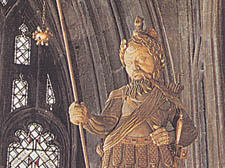|
|
 |
| |

Statue of the giants Gog, one of London’s legendary guardians, in the Guildhall |
Tall tales that have grown with time
Dan Carrier reviews a new book which recounts stories of the city now embroidered into the folklore of our times
The Folklore of London: Legends, Ceremonies and Celebrations Past and Present.
By Antony Clayton. Historical Publications £18.95
WHEN Jinny Jones was kidnapped picking daisies in a London field by the giant Gog, it fell to her friend Tom Tiddler to solve a series of London themed clues to rescue his young girlfriend.
Tom and Jinny were the subjects of writer Eleanor Farjeon’s 1929 book The Tale of Tom Tiddler. She used London place names and the folklore behind them to create a children’s classic. They include such vignettes as meeting the shepherd of Shepherds Bush, who lived in a copse, visiting the chalk producer at Chalk Farm and catching ready-to-fry fish at Battersea (get it?).
The author drew on the rich and varied history of the city, and while the folklore she used was a figment of her wonderful imagination, the Gog comes from one half of London’s legendary guardians Gog and Magog.
The pair feature in historian Anthony Clayton’s new work, The Folklore of London, which reveals the origins of the tales of our city.
Given the city’s age – founded by the Romans in AD43 – it must have been a huge task to filter through the urban myths and exotic tales to collate this marvellous piece of history.
It relies on the stories that people would have heard while in the saddle cantering through the hunting forests of the medieval period, quaffing ale at Elizabethan inns and theatres or carousing with the opposite sex at funfairs and sports grounds of the Victorian age.
“It is perhaps surprising for many Londoners to learn that their city has such a wealth of folklore,” says Clayton. “But those moving to London, certainly until the 20th century, were predominantly from rural communities and would have brought many of their local customs and legends with them.”
And as well as places and buildings carving themselves on our psyche, the book reveals the personalities, too.
“While certain popular characters such as King Arthur and Robin Hood belong almost wholly within the realm of legend, many prominent historical figures, whose lives are well documented, have also acquired an accretion of legend and unlikely tales,” he says. “In the 19th century the widely read “penny dreadful” periodicals helped embroider the stories of Dick Turpin and Spring-heeled Jack and led many to believe in the reality of the fictional Sweeney Todd.”
The chapter on legendary Londoners includes many characters connected to Camden and Islington.
We know Nell Gwyn, the lover of King Charles II, was rumoured to have lived in Lauderdale House for a time: the book recounts the story that she gave birth to one of Charles’s illegitimate children there, and dangled the infant from an upstairs window while the horrified monarch stood below – she said she’d drop the child unless it was given an honour, to which the King shouted: “God Save the Earl of Burford!” Apparently he was to become the Duke of St Albans in later years – perhaps the reason the soon-to-be-defunct pub on the corner of Swains Lane and Highgate Road was thus named, and the road that runs parallel to it.
Other pubs with rich histories include the Spaniards Inn. The origin of the name the Spaniards Inn has a number of sources: the Spanish ambassador to James I had a house on the site and his valet set up a pub there. In the 1721 two Spanish brothers owned the pub – they fell out over a woman, had a duel and managed to kill each other in the fight.
Further up the road, Jack Straw’s Castle also has a rich background: it was where Jack Straw, the leader of the 1381 Peasants Revolt, addressed the masses from the back of a hay cart. The rebellion was ignited by the deeply unpopular imposition of a poll tax the year before, and Jack Straw was one of the leaders, along with Watt Tyler, who marched on London to call for social justice.
Other Hampstead pubs feature: the Bull and Bush on the fringes of the Heath in North End Way, of the music hall song fame, was apparently the home of the artist William Hogarth, and some contemporary accounts claim he planned the pubs gardens, which were greatly admired – sadly now a car park.
And the Bull and Bush had other famous regulars: among those said to have frequented it include the actor David Garrick, Sir Joshua Reynolds, Thomas Gainsborough, John Keats, Percy Shelley, and Charles Dickens. Its name is straightforward: the grounds were once a cattle farm, and the custom of hanging over the front door a green branch to say you could buy beer and wine on the premises.
 |
| |
|
 |
 |
|
 |
|



